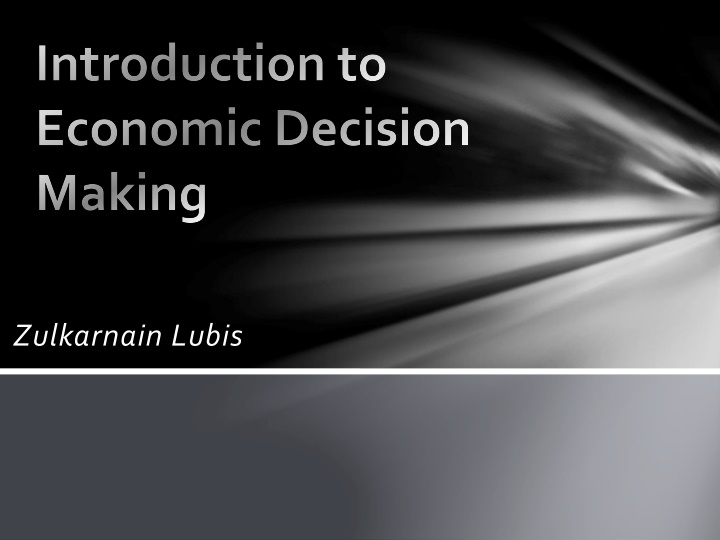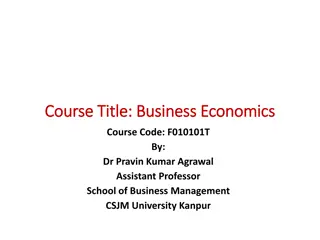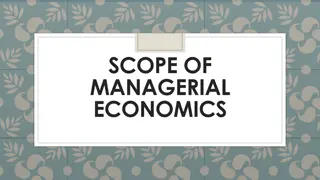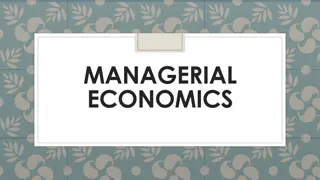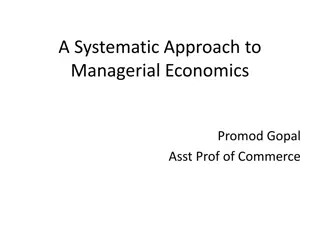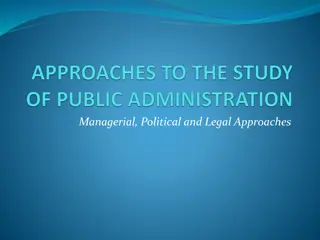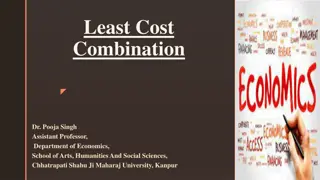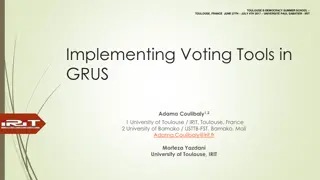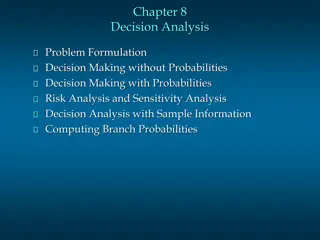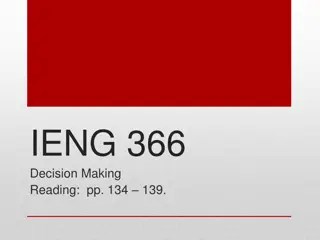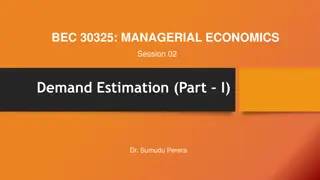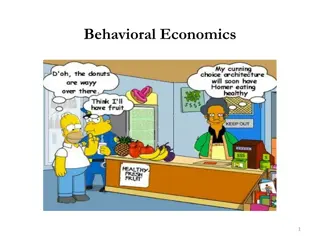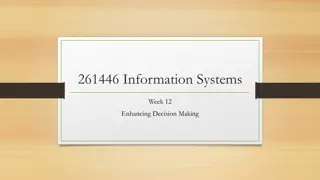Introduction to Managerial Economics and Decision Making
Managerial economics is the application of economic analysis in making business decisions to optimize the allocation of scarce resources. It involves utilizing quantitative techniques like linear programming and regression analysis to formulate sound business policies. The relationship between microeconomics, management, and quantitative methods plays a crucial role in managerial economics. Topics such as marketing, finance, strategy, and the impact of business decisions on the environment are also explored in this field.
Download Presentation

Please find below an Image/Link to download the presentation.
The content on the website is provided AS IS for your information and personal use only. It may not be sold, licensed, or shared on other websites without obtaining consent from the author.If you encounter any issues during the download, it is possible that the publisher has removed the file from their server.
You are allowed to download the files provided on this website for personal or commercial use, subject to the condition that they are used lawfully. All files are the property of their respective owners.
The content on the website is provided AS IS for your information and personal use only. It may not be sold, licensed, or shared on other websites without obtaining consent from the author.
E N D
Presentation Transcript
Introduction to Economic Decision Making Zulkarnain Lubis
What is Managerial Economics ? Economics is the study of the behavior of human beings in producing, distributing , and consuming material goods and services in a world scarcity Management is the discipline of organizing and allocating a firm s scarce resources to achieve its desire object Managerial Economics : the use of economics analysis to make business decisions involving the best use of an organization s scarce resources
Joel Dean : Managerial economics as the use of economic analysis in the formulation of business policies A big gap between the problems of logic that intrigue economic theorists and the problems of policy that plague practical management which needs to be bridged in order to give executives access to practical contributions that economic thinking can make to top-management policies Managerial economics is essentially a course in applied microeconomics that includes selected quantitative techniques common to other disciplines such as linear programming, regression analysis, capital budgeting, and cost analysis
THE RELATIONSHIP BETWEEN MICROECONOMICS, MANAGEMENT, QUANTITATIVES TECHNIQUES AND MANAGERIAL ECONOMICS MICROECONOMICS THEORY MANAGEMENT SCIENCE QUANTITATIVE METHODS
MARKETING FINANCE Capital budgeting Break-even analysis Opportunity cost Economic value added Demand Price Elasticity MANAGERIAL ECONOMICS MANAGEMENT SCIENCE MANAGERIAL ACCOUNTING Linear programming Regression Analysis Forecasting Relevant cost Break-even analysis Incremental cost analysis Opportunity cost STRATEGY Types of competition Structure-conduct performance analysis
PERUSAHAAN & LINGKUNGANNYA Pemilihan Input Konsumen Perusahaan Pesaing Pemerintah
Hubungan Masalah & Keputusan Bisnis Kualitatif : Pengalaman Bisnis Masalah Keputusan Informasi Kuantitatif : Produksi, Biaya, SDM
Pengambilan Keputusan Melibatkan Ekonomi Manajerial Perusahaan Tujuan Perusahaan Masalah-masalah Peranan Manajer mengambil Keputusan untuk mengatasi Masalah-masalah perusahaan & untuk mencapai tujuan Ekonomi Mikro Teori Pengambilan Keputusan Ekonomi Manajerial Solusi yang optimal untuk memecahkan masalah
5 Essential Questions to the Managers In Making Decisions
1. What are the economic condition s in a particular market in which we are or could be competing ? a. Market structure ? b. Supply and demand conditions ? c. Technology ? d. Government regulations ? e. International dimensions ? f. Future conditions ? g. Macroeconomic factors ? 2. Should our firm be in business ? 3. If so, what price and output levels should we set in order to maximize our economic profit or minimize our losses in the short run ?
4. How can we organize and invest in our resources (land, labor, capital, managerial skills) in such a way that we maintain a competitive advantage over other firms in this market ? a. Cost leader ? b. Product differentiation ? c. Focus on market niche ? d. Outsourcing, alliances, mergers, acquisitions ? e. International dimension-regional or country focus or expansion ?
5. What are the risks involved ? Typical of the types of risk that business face would be a. Changes in demand and supply conditions b. Technological changes and the effect of competition c. Changes in interest rates and inflation rates d. Exchange rate changes for companies engaged in international trade e. Political risk for companies with foreign operations
Microconomics Microeconomics: a study of individual consumers and producers in specific markets Supply and demand in individual markets The pricing of specific outputs and inputs Production and cost structure for individual goods and services The distribution income and output in population
Macroeconomic Macroeconomics: deals with the aggregate economy The analysis of the gross domestic product Unemployment Inflation Fiscal and monetary policy The trade and the financial relationsship among nations
Microeconomics is most used in managerial economics Macroeconomics must be also included , making decision is influenced by the current and future conditions of macro economy
The concept of scarcity and opportunity cost Economics is the study of how choices are made regarding the use of scarce resources in the production, consumption, and distribution of goods and services The key term is scarce resources and the scarcity means a condition in which resources are not available to satisfy all the needs and wants of specified group of people Opportunity cost: the amount or subjective value that must be sacrificed in choosing one activity over the next best alternative In the present of limited supply relative to demand, countries must decide how to allocate their scarce resources
The allocation decision can be viewed as comprising three separate choices : What goods and services should be produced and what quantities ? How should these goods and services be produced ? For whom should these goods and services be produced ? Three ways to answer the questions what, how, and for whom: 1. Market process; the use of supply, demand, and material incentives to answer the questions of what how, and for whom 2. Command process; the use of the government or some central authority to answer the three questions 3. Traditional process; the use of customs and traditions to answer the three questions
Economic Decision of the Firm From the Standpoint of a Company From the Standpoint of a Country What goods and services should be produced and what quantities ? The Production Decision The hiring, staffing, procurement, and capital budgeting decision How should these goods and services be produced ? For whom should these goods and services be produced ? The market segmentation decision
The principle objective of a firm is to maximize its profit (minimize its losses) Profit maximization hypothesis There are other goals that a firm pursued i.e. Market share Revenue growth Profit margin Return of investment Technology Customer satisfaction Shareholder value Difference goals can lead to very different managerial decision making given the same limited amount of resources
The optimal decision in managerial economics is one that brings the firm closest to the goal(s) i.e. For maximizing profit, a firm should price its product at a level where MR = MC Short Run vs Long Run During the short run, we assume a firm can vary the amount of certain resources but must be operate with a fixed amount of at least on of its resources In the long run, a firm is able to vary the quantity of all resources being used We assume a company goal s is to maximize both in the short and long run
Noneconomic Objectives Companies may have objectives that are not strictly economic or at least do not appear to be governed by economic thinking. There are some of guiding principles such companies publish : Provide a good place for our employee to work Provide good products/services to our customers Act as a good citizen in our society These are called as noneconomic objectives
MANAJEMEN BISNIS TOTAL DALAM SISTEM INDUSTRI MODERN Manajemen Bisnis Total mengintegrasikan : 1. Manajemen produktivitas total 2. Manajemen kualitas total 3. Manajemen sumberdaya total 4. Manajemen teknologi total 5. Manajemen biaya total TOTAL QUALITY MANAGEMENT Melalui pengembangan sumberdaya manusia yang handal untuk memperoleh hasil optimal yang berorientasi pada kepuasan konsumen
PERALATAN MANAJEMEN BARU UNTUK OPTIMISASI Alat yang paling penting adalah perbandingan (benchmarking), manajemen mutu terpadu (total quality management TQM), rekayasa ulang (reengineering), organisasi pembelajar (learning organization).
TQM (Total Quality Management) Berarti : Management of total quality (manajemen dari mutu terpadu) Quality management that is total in nature (Managemen mutu yang bersifat terpadu) Total management of total quality (Managemen terpadu dari mutu terpadu)
Pengertian dan Filosofi TQM MMT merupakan suatu demokratisasi dari metoda ilmiah (TQM is the democratization of the scientific method), dimana metoda ilmiah maksudnya adalah merupakan suatu proses yang sistematis yaitu bagaimana problem diidentifikasi, data dikumpulkan dan dianalisis, serta bagaimana kesimpulan yang akurat dapat ditarik berdasarkan analisis data yang diperoleh
Pengertian dan Filosofi TQM MMT dalam mengelola suatu organisasi haruslah berlandaskan atas D*A*T yaitu D untuk data, A untuk attitude (perilaku) , dan T untuk tools (alat); perilaku yang sejalan dengan MMT, memanfaatkan data dalam setiap pengambilan keputusan, serta menggunakan berbagai alat dan teknik tertentu dalam proses setiap pemecahan masalah dan dalam merealisasi perbaikan yang berkelanjutan
Manfaat TQM perbaikan pelayanan, pengurangan biaya dan kepuasan pelanggan untuk menghasilkan peningkatan kepuasan pelanggan peningkatan keahlian, semangat dan rasa percaya diri di kalangan penyelenggara perusahaan
Manajemen Mutu Terpadu Lima aturan untuk menentukan suksesnya suatu program TMQ Pejabat Eksekutif perusahaan (CEO) tegas dan nyata mendukung program tersebut Harus jelas keuntungan dari program tersebut Memiliki tujuan dan strategi Memberikan hasil keuangan dan kompesasi Program harus dibuat oleh perusahaan khusus
Producer Behavior Supply Function Production Function Production elasticity Isoquant Isocost Cost function (in terms of inputs and in terms of output) Inverse Demand Function Optimal Decision: Maximizing Profit
Customer Behavior Demand Function Indifferent Curve Utility Function Budget Line Income Effect Substitution Effect Optimal Decision: Maximizing Utility; Maximizing Satisfaction
Producer Behavior Market Equilibrium Customer Behavior
